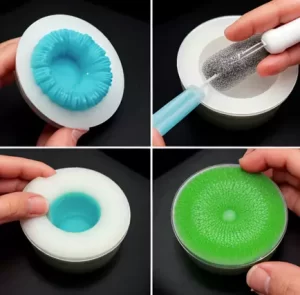Vacuum Casting, also known as vacuum injection moulding, is a process widely used in the field of rapid prototyping. The technology makes use of vacuum negative pressure to make liquid material flow and form in the mould, in order to manufacture high-precision and complex shape parts. In this article, we will introduce the process of vacuum casting in detail and discuss its specialised applications in various industries.

Vacuum casting process
1.Mould making
Master Model: Firstly, a high-precision master model is made by 3D printing, CNC machining or other rapid prototyping techniques. The Master Model is usually made of durable and stable materials such as ABS, polyurethane, etc.
Silicone Mould: Place the Master Model into a special frame, pour in liquid silicone and defoam it to ensure that the silicone completely covers the Master Model and there are no air bubbles. After the silicone has cured, the silicone mould is cut and the master mould is removed to form an accurate negative mould.
2.Material preparation
Liquid Resin: Select the appropriate liquid resin material according to the requirements, such as polyurethane resin, epoxy resin, etc.. These materials have good fluidity and curing characteristics and can be moulded in a short time.
De-foaming treatment: before casting, the liquid resin is de-foamed to remove the air bubbles in it to ensure the density and strength of the final product.
3.Pouring process
Vacuum environment: Put the silicone mould into the vacuum chamber and pour the liquid resin into the pouring port. Under the vacuum environment, the negative pressure makes the liquid resin more fluid and fills the mould cavity quickly to avoid air bubbles.
Curing moulding: Keep the vacuum environment and wait for the resin to cure in the mould. Depending on the resin material, the curing time varies from a few minutes to several hours.
4.Demoulding and post-processing
Demoulding: After the resin is fully cured, open the vacuum chamber, remove the silicone mould and carefully take the finished product out of the mould.
Post-treatment: According to the product requirements, the finished products will be subject to necessary post-treatment processes, such as deburring, sanding, painting, etc., in order to achieve the final product requirements.

Vacuum casting applications
1.Rapid prototyping
Verification of design: Vacuum casting enables rapid production of highly accurate prototypes for verification of product design and functionality. This is important for the development and iteration of new products.
Market testing: Through vacuum casting, a small number of products can be quickly produced for market testing, helping companies to understand market feedback before formal mass production.
2.Small batch production
Reduce costs: For products that require small batch production, vacuum casting is a cost-effective manufacturing method that avoids the problem of high mould opening costs.
Shorten the cycle: vacuum casting production cycle is short, can quickly respond to market demand, shorten the time to market.
3.Complex parts manufacturing
High precision: vacuum casting can produce parts with complex geometry and fine details, widely used in electronics, medical, aviation and other high-precision industries.
Multi-material selection: by choosing different types of resin materials, vacuum casting can meet the special needs of different fields, such as high temperature resistance, corrosion resistance, insulation and other characteristics.

Advantages and Challenges of Vacuum Casting
1.Advantages
High precision and complexity: Vacuum casting can realise the manufacture of parts with high precision and complex shapes, with an accuracy of up to ±0.1mm.
Flexibility: applicable to a variety of resin materials, can be flexibly selected according to demand, to achieve different performance of parts manufacturing.
Rapid and efficient: the whole process from mould making to the finished product out of the mould, the cycle time is short, suitable for rapid prototyping and small batch production.
2.Challenges
Limited choice of materials: Currently, polyurethane resin is mainly used, and the application of certain materials with special properties is limited.
Limited mould life: Silicone moulds have a relatively short service life, usually need to be replaced after 20-50 castings, which increases the cost of long time mass production.
Complicated process: professional equipment and technicians are required to operate, and the production environment is more demanding.

Future Prospect
With the progress of science and technology and the development of material science, vacuum casting technology will further improve its accuracy, material selection and production efficiency.
In the field of industrial design, medical devices, aerospace and other fields, vacuum casting will play an increasingly important role in promoting the manufacturing industry to a more efficient and accurate direction.
Conclusion
Vacuum casting, as an efficient and flexible rapid prototyping technology, has a wide range of application prospects. Through continuous technological innovation and process optimisation, vacuum casting will provide more high-quality parts and components for various industries, helping product development and market competitiveness.
